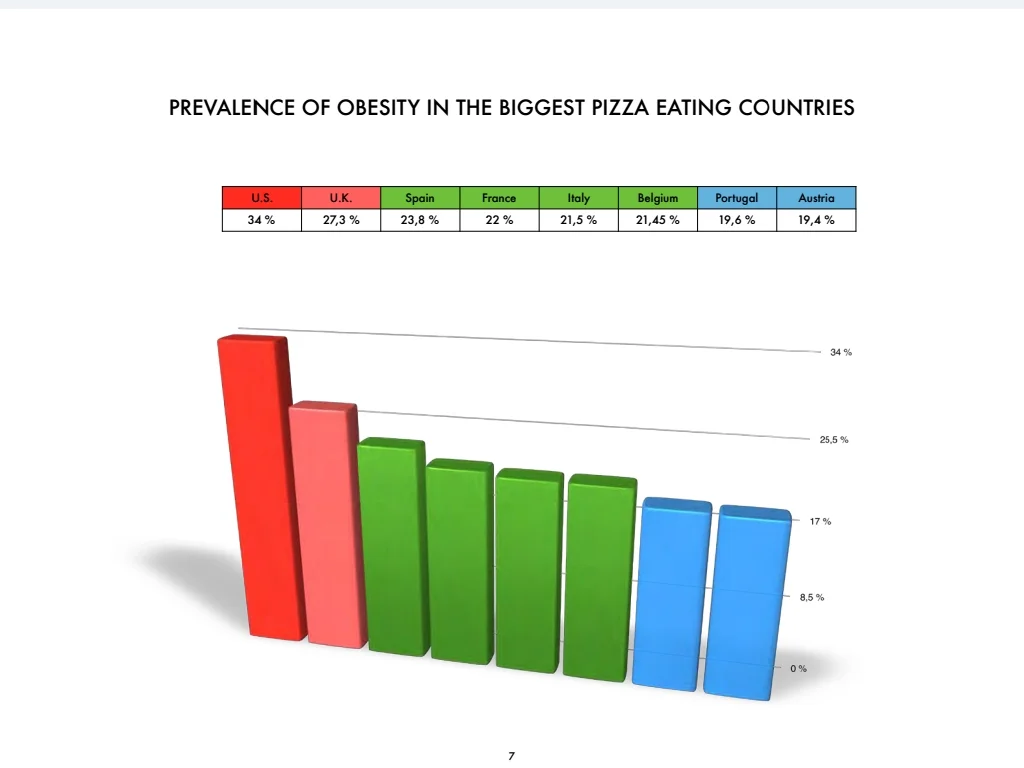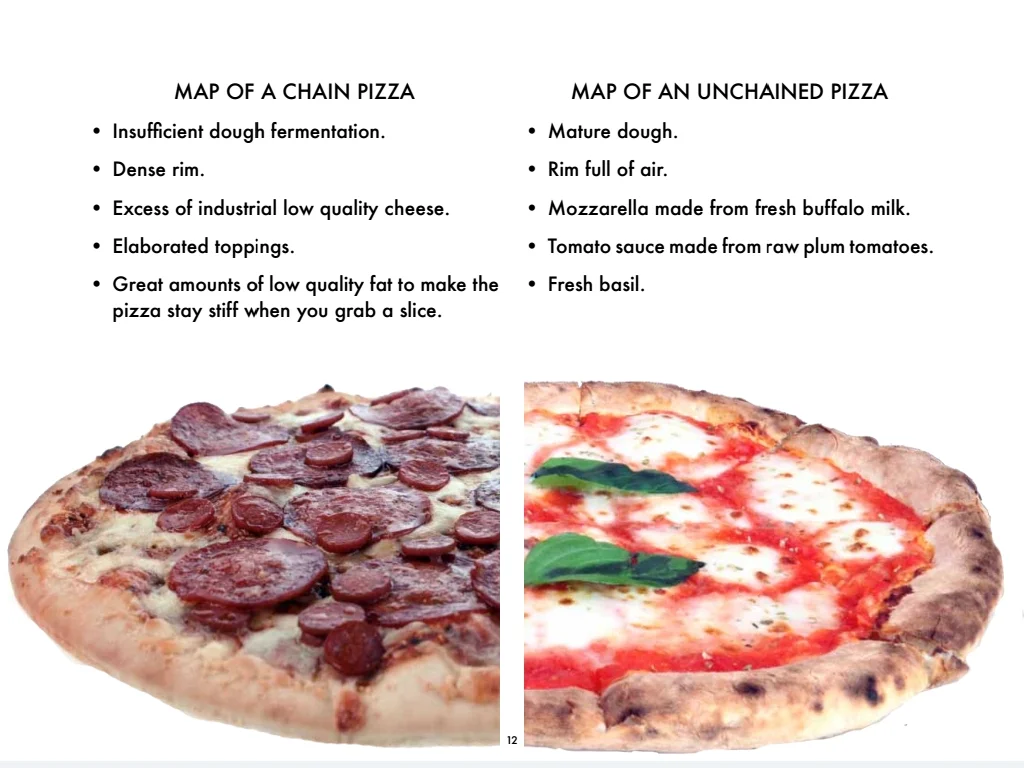Many people outside of Italy believes that pizza is a fattening junk food that leads to obesity. In my opinion, this is because they only know bad pizza from fast food pizza chains.
As a backlash, a movement has started in Italy. Their aim is to keep the traditional knowledge of making Neapolitan pizza alive. The art of Neapolitan pizza making is now (2018) on the UNESCO List of the Intangible Cultural Heritage of Humanity.

The top consumers of pizza in the world are the U.S. (13 kg per person a year), Italy (7.5 kg per person a year), Spain (4.2 kg per person a year), France (4.1 kg per person a year), U.K. (4 kg per person a year) Belgium (3.8 kg per person a year), Portugal (3.5 kg per person a year) and Austria (3.2 kg per person a year).
In regards to prevalence of obesity (see chart on next page), Italians are slimmer than British, although they eat almost twice as much pizza. This suggests that there is no direct correlation between consumption of pizza and obesity.
In U.S. and U.K. obesity is was the highest. This implies a correlation between junk food, such as chain pizza, and obesity, and not pizza per se.

Pizzaiolo means Pizza Maker in Italian. In Italy a decent Pizza Maker is respected and well paid. A good Italian Pizza Maker is probably a second or third generation of a family of Pizza Makers. Some of them have their own secret recipe that they never share with anyone.
An Italian Pizza Maker might be expensive and hard to get in India. However, an Indian Pizza Maker most probably does will not know how to make an authentic good pizza. Even the chefs, who, that are often are expected to cook many different cuisines, does not have the skills to make a good pizza.
I suggest the owners get involved with a hands on approach. This would make sure ensure an overall better outcome and less dependability on the employees. For example,: in case f your Pizza Maker would joins another company, you can trarainin a new one.
In India, during the last two decades, I have witnessed a change from low quality chain pizzas to “thin crust” pizzas. The later one is in India is still considered the “gourmet alternative”. The thin crust is also one of the most common pizzas internationally. The thin crust is generally unchained but beside that it does not have any of the features that characterize a good pizza. You do not need ingredients of specific quality or freshness to make a thin crust pizza. Neither does it need a skilled pizza maker as , the pizza base is often stretched with a rolling-pin. You do not even need a wood fired oven since it is cooked at lower temperature than Italian pizzas.
The one who makes thin crust is aiming to distinguish themselves from the chain pizza, commonly known as unhealthy, by offering a thin crust and pushing it as the “gourmet” or “authentic”. Since they will not cater to the connoisseurs, they offer an alternative to chain pizza. By doing that they satisfy the one who does not like chain pizza, by making the it thinner and crisper. English-speaking celebrities in media are pushing the “thin crust” pizza as the Italian pizza and using fancy words to sell it. In reality, they are choosing the most commercial Italian pizza and making it even more commercial by adding any random topping. Often it comes with a zigzag of sauce on top, or with ketchup. This would not happen in Italy. In my opinion, the thin crust is a thinner version of the chain pizza.
Pizza has been made in Naples since the 18th century. During this time, Naples was one of the largest cities in Europe. Most citizens did not have access to a kitchen. Pizza was common food and sold in every corner of the streets. Their dough has a high water content and does not contain any fat. This makes the pizza very soft and chewy. The Leopard spotting happens when the pizza cooks above 400°C for around 60 seconds. The rim has a lot of air since the Pizza Maker, while stretching the pizza, pushes the air in the dough towards the edge with his hands.
The Vera Pizza Neapolitan is the only pizza that has a fixed standard (see Appendix I) that is regulated by Associazione Verace Napoletana (AVPN). AVPN is a nonprofit organization, founded in Naples 1984 to promote and protect the original Neapolitan pizza. The standard covers everything, from the brands of the ingredients, to the methods of making and cooking.
The AVPN pizza only comes in two varieties: Marinara and Margherita. The pizza cooks in special Neapolitan brick ovens , at a temperature above 400°C for around one minute.
The AVPN standard hasn’t yet never been obtained in a pizzeria in India. My reason behind explaining you what is the standard are mainly informative.
Pizza Classica is the most common pizza in Italy and, it is also popular among pizza connoisseurs. The dough has a high water content, contains a little oil, and cooks at a slightly lower temperature than the Neapolitan Pizza. It is generally thinner than the Neapolitan but thicker than the Romana (see next page). Also the shape of the Classic Pizza is generally round similar to , just like the Neapolitan Pizza.
There are many variations of the Classic Pizza. There is no disciplinary. So all the pizzerias decide their varieties. The dough is either Straight or Polish (see page 20), and made with different flour such as brown wheat flour, Khorasan wheat flour , or even gluten-free flour. Many pizzerias also offer “white pizza” which is a pizza without tomato sauce.
Romana Pizza has low water content in the dough, sometimes to a point that its hardness makes it impossible to stretch by hands. The dough has usually seeds oil. The Seeds oil is, used, although it is a lower quality fat, is used because it helps to make the pizza crispy.
Romana pizza can either be cooked in the wood fired oven, at a lower temperature, for a longer time, and with less flames, or in a gas oven. In Italy the Romana Pizza is often sold in bakeries by the kilo or by slice, sometimes in larger sizes or in oblong shape.
If you set up your pizzeria in a posh market I recommend you to offer Neapolitan or Classic pizza. This will attract traveled connoisseurs, foreigners and nonresident Indians. With a superior product and premium ingredients you can price your pizza accordingly. If you choose Classic pizza, you can experiment more and meet your customers taste than with the Neapolitan pizza.
If you set up your pizzeria in a more laid back area I recommend you to offer Classic or Romana pizza. The Neapolitan is too authentic for this kind of market. The Romana is the safe card; : it does not stand out and rarely gives rarely any complains. You could still offer some premium toppings, although most of your customers will choose the toppings that they are already accustomed to.
Recently a few places in India have introduced pizzas that are similar to the Neapolitan, with a good feedback. They have found their niche and had relatively faster and steadiery growth. The positive response could be explained by the fact that Neapolitan pizza is an excellent product and there are less competition for that kind of pizza.